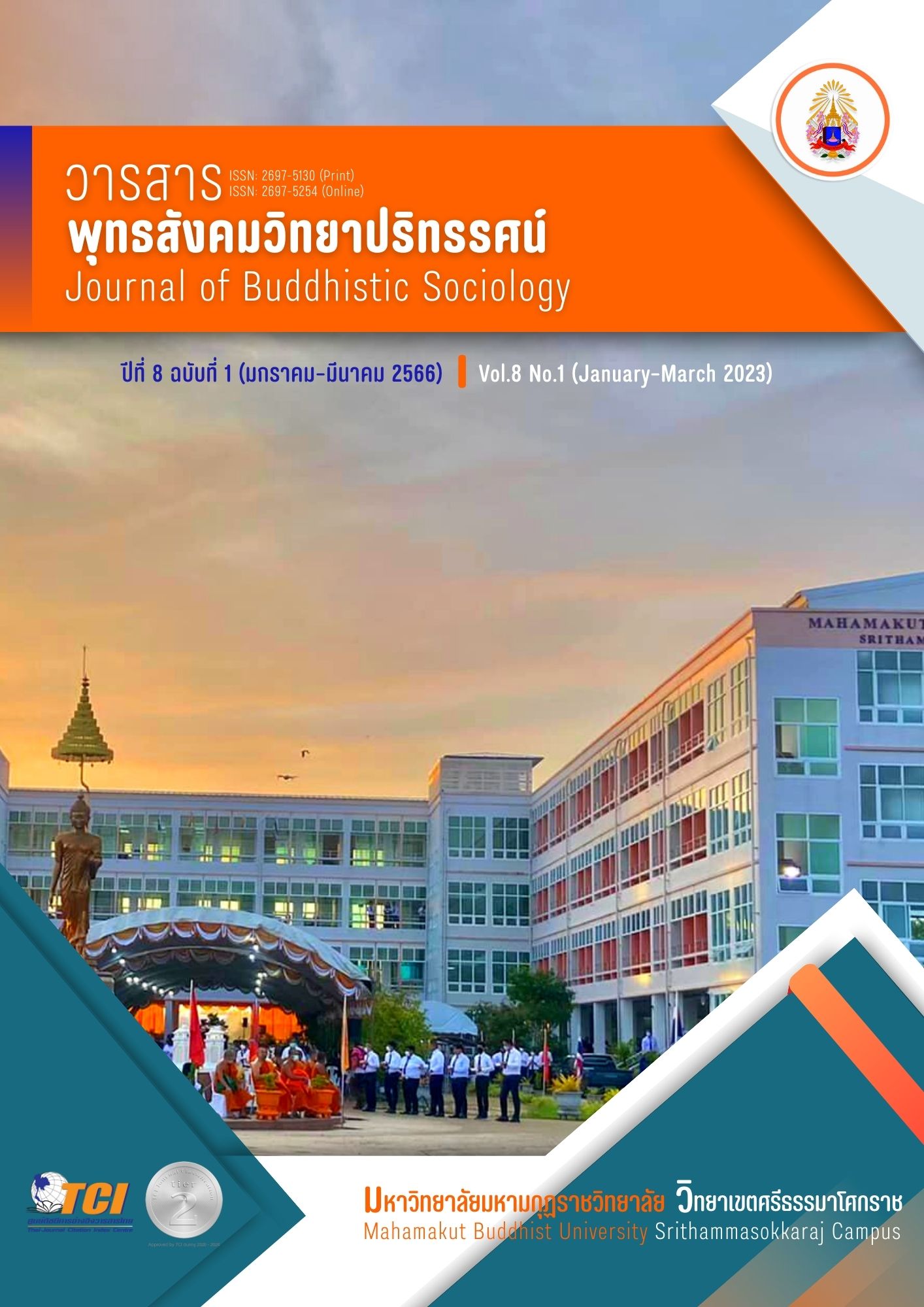การประเมินโครงการปรับบ้านเป็นห้องเรียนเปลี่ยนพ่อแม่เป็นครู ศูนย์การศึกษาพิเศษประจำจังหวัดกระบี่
Main Article Content
บทคัดย่อ
การประเมินโครงการปรับบ้านเป็นห้องเรียนเปลี่ยนพ่อแม่เป็นครู ศูนย์การศึกษาพิเศษประจำจังหวัดกระบี่ มีวัตถุประสงค์เพื่อ 1) ประเมินบริบทของโครงการ 2) ประเมินปัจจัยนำเข้า 3) ประเมินกระบวนการของโครงการ และ 4) ประเมินผลผลิตของโครงการ กลุ่มตัวอย่างในการวิจัยครั้งนี้ ได้แก่ ครู และบุคลากร 44 คน พ่อแม่ ผู้ปกครอง 73 คน เครื่องมือที่ใช้ในการประเมิน คือ แบบสอบถามมาตราส่วนประมาณค่า 5 ระดับ จำนวน 4 ฉบับ และการพัฒนาศักยภาพเด็กพิการตามที่กำหนดไว้ในแผนการจัดการศึกษาเฉพาะบุคคลหรือแผนการให้บริการช่วยเหลือเฉพาะครอบครัวโครงการปรับบ้านเป็นห้องเรียนเปลี่ยนพ่อแม่
เป็นครู ศูนย์การศึกษาพิเศษประจำจังหวัดกระบี่ ปีการศึกษา 2564 ที่ได้จากแบบบันทึกผลตามสภาพจริงจากฝ่ายวิชาการหรือครูประจำชั้น สถิติที่ใช้ ได้แก่ ค่าร้อยละ (Percentage) ค่าเฉลี่ย (Mean) และค่าเบี่ยงเบนมาตรฐาน (Standard Deviation)
ผลการวิจัยพบว่า
1. ด้านบริบทของโครงการปรับบ้านเป็นห้องเรียนเปลี่ยนพ่อแม่เป็นครู ศูนย์การศึกษาพิเศษประจำจังหวัดกระบี่ มีความเหมาะสมโดยรวมอยู่ในระดับมาก
2. ด้านปัจจัยนำเข้าของโครงการปรับบ้านเป็นห้องเรียนเปลี่ยนพ่อแม่เป็นครู ศูนย์การศึกษาพิเศษประจำจังหวัดกระบี่ มีความเหมาะสมโดยรวมอยู่ในระดับมาก
3. ด้านกระบวนการดำเนินงานของโครงการปรับบ้านเป็นห้องเรียนเปลี่ยนพ่อแม่เป็นครู ศูนย์การศึกษาพิเศษประจำจังหวัดกระบี่ มีความเหมาะสมโดยรวมอยู่ในระดับมาก
4. ด้านผลผลิตของโครงการปรับบ้านเป็นห้องเรียนเปลี่ยนพ่อแม่เป็นครู ศูนย์การศึกษาพิเศษประจำจังหวัดกระบี่
4.1 ผลที่เกิดจากการดำเนินงานตามโครงการปรับบ้านเป็นห้องเรียนเปลี่ยนพ่อแม่เป็นครู มีความเหมาะสมโดยรวมอยู่ในระดับมาก
4.2 การพัฒนาศักยภาพเด็กพิการตามโครงการปรับบ้านเป็นห้องเรียนเปลี่ยนพ่อแม่เป็นครู ผลการพัฒนาการศักยภาพเด็กพิการตามที่กำหนดไว้ในแผนการจัดการศึกษาเฉพาะบุคคลหรือแผนการให้บริการช่วยเหลือเฉพาะครอบครัว ปีการศึกษา 2564 พบว่าผู้เรียนผ่านเกณฑ์การประเมินร้อยละ 100
Article Details

อนุญาตภายใต้เงื่อนไข Creative Commons Attribution-NonCommercial-NoDerivatives 4.0 International License.
เอกสารอ้างอิง
กระทรวงศึกษาธิการ. (2542). พระราชบัญญัติการศึกษาแห่งชาติ พุทธศักราช 2542. กรุงเทพมหานคร: สยามสปอรต์ ซินดิเคท.
กระทรวงศึกษาธิการ. (2545). พระราชบัญญัติการศึกษาแห่งชาติ พ.ศ. 2542. และที่แก้ไขเพิ่มเติม (ฉบับที่ 2) (พ.ศ. 2545). กรุงเทพมหานคร: พริกหวานกราฟฟิค.
ดวงชนก ลันดา และจรูญเกียรติ กุลสอน. (2559). การพัฒนาการเรียนรู้นักเรียนที่มีความต้องการจำเป็นพิเศษโดยครอบครัวและชุมชนในจังหวัดชัยภูมิ. วารสารวิชาการแและวิจัยสังคมศาสตร์, 11(33(1)), 13-24.
บุญชม ศรีสะอาด. (2560). การวิจัยเบื้องต้น (พิมพ์ครั้งที่ 10). กรุงเทพมหานคร: สุริยาสาสน์.
ประพันธ์ โพธิ์หย่า. (2553). ผลการประเมินโครงการปรับบ้านเป็นห้องเรียนเปลี่ยนพ่อแม่เป็นครู ศูนย์การศึกษาพิเศษประจำจังหวัดอุตรดิตถ์. อุตรดิตถ์.
สมพร หวานเสร็จ. (2553). ประเมินโครงการปรับบ้านเป็นห้องเรียนเปลี่ยนพ่อแม่เป็นครู. ใน รายงานวิจัย. สำนักบริหารงานการศึกษาพิเศษ.
สำนักงานเลขาธิการวุฒิสภา. (2560). รัฐธรรมนูญแห่งราชอาณาจักรไทย พุทธศักราช 2560 (พิมพ์ครั้งที่ 3). กรุงเทพมหานคร: สำนักงานเลขาธิการวุฒิสภา.
สำนักบริหารงานการศึกษาพิเศษ. (2550). แนวทางปฏิบัติงานของศูนย์การศึกษาพิเศษ. กรุงเทพมหานคร: โรงพิมพ์คุรุสภาลาดพร้าว.
เอนก ไชยวงศ์. (2555). การศึกษาผลการพัฒนาการเด็กพิการตามโครงการจัดการศึกษาสำหรับเด็กพิการโดยครอบครัวและชุมชน ปีงบประมาณ พ.ศ. 2553-2554 ของศูนย์การศึกษาพิเศษประจำจังหวัดแม่ฮ่องสอน. แม่ฮ่องสอน: สำนักบริหารงานการศึกษาพิเศษ สำนักงานคณะกรรมการการศึกษาขั้นพื้นฐาน.
Best, J.W. (1970). Research In Education (2nd ed.). Englewood Cliff, New Jersy: Prentice-Hall.
Stufflebeam, D.L. & Shinkfield, A.L. (1983). Systematic Evaluation. Boston/Lancaster: Kluwer-Nijhoff Publishing.


